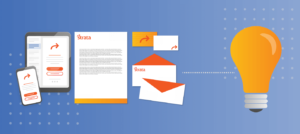Make a Mint off of Print
In last week’s blog, part 1 of the Power of Print series, we discussed how powerful print marketing really is, and how beneficial it can be as a central branding and promotional tool. This week, we have for you, part 2 of the series. Now that you’re convinced of its importance and relevance, we’re giving you key tips and tricks your business can use to enhance the power of your print marketing.
We know you’re busy, and you likely want to save all the time you have for productive business efforts and possibly some great marketing, so, we’re making this a quick and easy read. Like we said, we have more than a few (8, to be exact) top practices to create effective print marketing materials…
8 Ways to Improve the Power of Your Print
Know Your Audience
Any print material you distribute should be at least somewhat personalized and developed with your key audience in mind. Make sure your messaging and visuals speak to the people you’d like to reach above all else. Before even creating your print marketing materials, take time to research and understand your audience, looking into not just their wants and needs, but also their pain points and expectations.
Don’t Push Design Aside
You may think design can come as an afterthought – the last piece of pulling it all together and getting your marketing printed, but the total opposite should take place. Think through your visuals just as you would your content and call outs. Use them to connect with your audience and grab their attention. And, don’t skimp. Print’s already very cost effective, so spending that extra bit on design, paper, and colors is worth it, and could be the reason your audience starts to love your brand or continues to be loyal.
Have a Clear Message
When you’re dealing with print, there’s usually a limited amount of space available, at least compared to digital. There’s not as much room to “say it”, so your forced to “say it right” (which can be a great thing when determining necessary messaging to entice customers with fleeting attention spans). Make sure your message, especially your call to action (what you want the customer to do or know) is loud and clear – not hard to find. Don’t clump all of your products into one postcard. Instead, feature a few products, or better yet, use data to personalize the material and feature that specific customer’s favorite merchandise.
Make it Relevant
We’d like to reiterate – because of just how important it is – to always research, understand, and consider your target demographic before creating print materials. Why would your product or service interest them? Why would they need it? How could your material catch their eye? Personalizing this content will make it much more memorable and impactful. In fact, in a study conducted in 2019, 72% of consumers claimed they only engaged with marketing messages that were customized to their specific interests.
Engage the Senses
When it comes to creating print marketing, don’t just think about what the eyes can see. Print marketing is very much a multi-sensory experience. Consider textures, sounds, and scents (yes, scents!) that evoke feelings within your customer – whether those feelings are excitement, envy, importance, or nostalgia. Incorporating a three-dimensional effect, such as a texture, embossing, or thicker areas of material, can help your print marketing stand out among the rest.
Use a Call to Action (CTA)
Like we said before, you want your call to action to be loud and clear. You don’t want your potential customer setting down your print material without clarity on what you’d like them to do. Make sure to include your address, phone number, and any other applicable contact information like an email address or social account(s). Consider including a coupon for them to use or a sign up for a rewards program, subscription, or membership.
Combine it with Digital
Gain trust and credibility by incorporating digital touches within your print marketing, like QR codes, PURLs, social accounts, and other web references. The best part? Doing so will make campaign attribution a breeze, and will make it easier for you to follow up with interested customers.
Pick the Perfect Printer
The last step of any print marketing process is finding the right printing company to work or partner with – that has affordable yet reasonable rates – and quality print products. Seek out a company that will not only print your materials, but will care about your bottom line and success (almost) as much as you do. They’ll likely offer a variety of printing options, and will have a creative vision for your campaign and/or overall marketing.
Not to toot our own horn (okay, maybe a little), but at Strata, we’re print experts and it’s in our DNA. We’re prepared to work with you whenever you’re ready to brainstorm your next print marketing project. Just contact us when you’re prepared to make smart happen.
The Who, the Why, and the How
In part 1 of the All About Branding blog series, we talked about what branding is, why it’s so important, and how to tell if it truly matches your products or services. Now, we’re seeing if your brand also matches something just as important – your customers. But first, let’s discuss who exactly your customers are, as well as your greatest fans and loyal supporters (your customer base).
Who Are Your Customers?
You may think your customers are simply the people that enter your store, call your company, or send you an email. And you’re right – they are. But those aren’t your only customers. There are actually many different types of customers that you may not even be aware of. For example, those who visit your site, hear about your product or service via word of mouth and plan to call you or visit your site this week, or those who have visited your shop or thought about your product, but haven’t returned – in person or online. There are loyal and engaged customers (maybe they have a subscription to your service or consistently order your product), and there are those you don’t see (who like your social media photos or talk about your product to friends and family). Customers and potential customers come in all shapes and sizes, and it’s important you think about all of them no matter what type of business you run.
A customer base, on the other hand, is the group of people who are loyal to your business! They not only buy and love your product, but talk about it often and maybe even post about it on social media. They’re engaged in your happenings and come back again and again for your offerings. “These shoppers may be loyal to your brand for a number of reasons…you offer them a product they want or need, your brand’s messaging resonates with them, or they enjoy being involved in your brand community.”
When it comes to your brand, you also don’t want to forget about those you communicate with on a daily, weekly, monthly, or even yearly basis. The wholesalers, retailers, and vendors you work with should all get a good sense of your brand as well, whether that be by how you speak to them over the phone, the tone you use in your emails, or the branding materials you send them online or in the mail.
And, although it’s easy to pass by the importance of learning about your customer base, as well as understanding this base and catering to it, it’s essential for your business and brand. In a recent study of 1,900+ business professionals, 45.9% said their #1 priority for the next 5 years was customer experience (even over pricing and product). And consumers agree with this notion. Statistically, “76% of customers expect companies to understand their needs.”
What is Your Why?
Knowing the “why” of your business is an integral part of understanding and building your brand. You need this as a foundation to decide on all other aspects, such as your goals, your ideal customer base, and inevitably, your brand. Ask yourself questions about your company, like:
Once you’ve answered all of these questions, you’ll have the tools you need to determine your ideal customer base and make other valuable decisions for your business, and when you have a better idea of your target audience, the rest comes together fairly smoothly. The better your understanding of this base, the easier it is to retain them. Here are four simple steps to further identify your target customers:
1. Outline your audience – describe their lifestyles, situations, wants, and needs. Maybe come up with a fake customer persona to lead you in the right direction.
2. Note their pain points, and how you can provide solutions.
3. Think about what’s at stake if their needs aren’t met.
4. Think about the payoff if their needs are met.
Understanding your customers’ wants, needs, personalities, and actions, and thinking through how your product/service can relate to these, will ultimately facilitate to great success for your company.
Does Your Brand Match Your Customers?
What you find in your research of your ideal customer base will contribute heavily to how you define your brand. Is your target audience wealthy, with high expectations? Do they demand exceptional service? Brand your business to be high class, with a product that uses the best and rarest finds. Oppositely, maybe you find your business to be a low-budget, large family’s go-to product. Market it as family and budget-friendly, with consistent offers and an understanding staff. Another example? Maybe your customer base is all about the young, the new, and the trendy. Create a modernized website, consistently post on social, and make sure to be on TikTok. Simply meet your customers where they are, where they’re going, and where they want to be…and be a brand they connect with mentally and physically.
Knowing your customer base and creating (and upholding) a brand to match it is imperative to maintaining and growing a great business. Add loyal brand advocates to your adamant customer base by engaging with them beyond the first purchase, and showing them consistent, inviting brand messaging. Don’t just sell them your product, but remind them again and again of your friendly service, amazing offerings, and unique brand and message. Implement strategies and services, such as loyalty programs, social media campaigns, and exemplary customer service, to turn strangers to visitors, visitors to customers, and customers to promoters – who will promote your brand for free through word of mouth.
Identifying your customer base from their lifestyles, to their situations, problems, implications, and needs, is the best way to build a brand that meets them where they are, and where they’re going. Looking to improve or streamline the branding of your marketing campaigns and messaging? Contact Strata to brainstorm some ideas that can help you connect with new and returning customers in a meaningful, on brand way.
From Tagline to Talk
Although Strata doesn’t specifically create and implement branding services, we work with and use brand standards to create marketing materials day in and day out. We’ve seen great (and not so great) brands, and know what makes a brand stand out among competitors. Branding isn’t just a buzz word – it’s important no matter how big or small your company. It isn’t simply a logo and consistent colors – although it is these things. It’s also the way you make your customers feel, the experiences you provide, and the language you use to describe your products and services. Whether it’s known or faintly and unknowingly distinct, you have a brand and an image you’re putting out there…but is it purposeful? And is it the right one? We’re bringing you some best practices to make sure your brand truly matches the product or service you offer.
What is Branding?
Today, in a vast plethora of options to choose from no matter what industry, using tools to distinguish your business, from your logo to your services, is more important than ever. A brand is what helps you set your company apart from other businesses. It’s “a feature or set of features that distinguish one organization from another…typically comprised of a name, tagline, logo or symbol, design, brand voice, and more.” But it isn’t just the visuals. It’s the feeling and experience the customer gets from interacting with your business, whether that’s in person, on the phone, on social media, on your website, or somewhere else. Branding, as an action, is setting up these features, from tagline to talk. It involves understanding your product, why customers love it, and catering to those current and future customers with a distinct and memorable experience. “It’s what transforms first-time buyers into lifetime customers and turns an indifferent audience into brand evangelists.”
Why is Branding so Important?
Even if you don’t think you do, you definitely have a brand. Maybe your customers say “I love that company. Every time I call their customer service is kind, and their products make me feel great. I also love their cute and simple logo. I’d definitely buy a t-shirt.” There’s your brand right there. Your customers perceive these brand elements, have reactions to them, and choose to give you additional business. Yet, the smallest of hiccups can ruin a brand. A few wrong moves or interactions with unpleasant employees can cause your business to be looked at a lot differently, and can change the experience for everyone. It’s important to know, understand, and nurture this brand to continue to grow – and not lose – your customer base. Branding can help you “establish the ways in which you’re different, special, and unique. And it shows your customers why they should work with you instead of your competitors.”
Visuals are of course just as important as feelings. Especially now, in 2021, brands are urged to reach further in their experimentation and uniqueness, creating eye-catching logos, websites, social media imagery, and merch. More and more, companies are expected to be “instagrammable” in their image. Kids, teens, and even adults are intrigued by the idea of getting a good photo for their social accounts. Not every store or business has to attempt this atmosphere, but there should still be some thought behind who you want to be and how you want to be seen.
Simply put, branding gives your company an identity, makes it memorable, helps you create and solidify marketing, and gives your employees and fans something to talk about and be proud of. It can increase the value of your company to give you more leverage in the industry, and thoroughly establishes trust (for partner brands and customers alike). Basically, you’ll look a lot more professional if your brand isn’t just an accident, but is planned, deliberate, and easily recognizable.
Does Your Brand Match Your Product/Service?
Now that you know its importance, take a minute to think about your brand. Does it match who your company is, your products and/or services, and the feeling you hope your customers get when they interact with your business? Does it portray the taste, the look, the feel, the scent, the sounds of whatever you sell? If your answer is “no” or even “I’m not sure,” it may be time to dig a bit deeper into what exactly you’re putting out there for the world to see, digest, and associate with your company.
Maybe you’d describe your company as traditional and authentic. The original idea for your product dates back to the mid 1900s. Don’t hesitate to promote and communicate this in the imagery and messaging of your marketing materials. Maybe use a traditional typeface, a nostalgia-inspired logo, and incorporate some authentic, vintage music into your videos. Oppositely, maybe you’d classify your company as new-age, experimental, unique, trendy, and fun. Use modern branding styles, popular music, and distinctive, trendy content to further create a stylish and hip experience that matches your product.
Psychologically, humans don’t like to think too hard. They like when things are easy to decide on, and when they make sense. Make their decision easy by providing great customer service with a great product or service. Combine multiple unified brand elements so their brain can relax and enjoy the environment. Humans are also terrified of missing out (hello FOMO) – so create a branded experience that’s too good to pass up (aka, inspires FOMO). Make sure your business has a distinguishing look and feel that makes customers (or even potential employees) want to talk about it and brag about it – whether by word of mouth or through a hashtag.
Before starting your next campaign, use this knowledge to think just a bit deeper into your products or services and the story you’re sharing with the world. Make sure your company’s identity is not only one that you’re proud of, but one that exemplifies your offerings and differentiation from competitors. If you’re looking to improve the reach of your brand, contact Strata today to set up an on-brand campaign that utilizes crafted messaging that will help capture and inspire new and returning customers.
Best Practices & Use Cases
What We’ve Learned (So Far)
In Part 1 of the Omnichannel Marketing 101 Series, we went over exactly what omnichannel marketing is, not only including its actual definition, but how it differs from multichannel marketing, its importance, and examples of when, where, and how it’s used. In Part 2, we outlined the steps to getting started on an omnichannel campaign. From those two blogs, we hope you’ve seen that omnichannel marketing’s an excellent way to gain and retain customers, and that it’s maybe not as intimidating as it sounds, but does require research, planning, focus, and sometimes, a team of experts like us!
Now, we’re giving you the inside scoop and sharing just a few of our secrets (yes, our secrets!) on best practices for creating an omnichannel campaign that powers a unique customer experience and cultivates company success.
What Industries Can Benefit from Omnichannel Marketing?
One of the many reasons omnichannel marketing is so popular is because of its versatile nature. It can be used in many different ways across several industries. Here are just a few we’d like to highlight…
Telecom
Omnichannel marketing is often used by the telecom industry to conduct various tasks, such as helping customers make payments and send out new launch notifications. As a result, telecom companies can quickly boost revenue and drive engagement.
Travel
Travel agency customers go through numerous stages in their customer journeys. Omnichannel campaigns can help promote travel accommodations, send reminders about upcoming flights and delays, deliver other announcements, give out deals for restaurants, stores, and hotels, and keep an open line of communication that’s easily accessible to the customer.
Banking
There are several ways banks can use omnichannel marketing – from reminding their customers about impending bills and other costs, to providing account balances, and promoting new features or products. It streamlines their services and allows them to offer multi-device experiences that often save the customer time (and improves their patience).
Healthcare (Our Specialty)
Strata has helped many healthcare companies acquire and retain customers using smart and successful omnichannel campaigns. Marketing campaigns can be tough to create and execute in a highly regulated industry like healthcare, but omnichannel marketing has taken off, and more and more healthcare companies are utilizing it. Healthcare companies can use omnichannel campaigns to reach new movers in their area, connect them with physicians, send out appointment reminders, provide additional access to portals…the possibilities are kind of endless.
With all of that in mind, you can see why businesses that create and conduct omnichannel strategies have 91% greater year-over-year customer retention rates. So, even if you’re in a different industry than the four above, you don’t have to miss out. Read on to learn more about the best practices for creating successful omnichannel campaigns…
Creating the Perfect Omni-Strategy
When planning out an omnichannel strategy, it’s most important to research, collect data, and, well…thoroughly plan. Not only do you want to research and keep in mind the customer base you’re targeting, but you’ll want to examine how your customer base will experience each channel, and carefully prepare the different messages you’ll want and need to communicate to them. Like we said in our second blog of the series, knowing your customers inside and out is key to a successful omnichannel campaign. Learn their demographics, environments, behaviors, habits, and even their goals. Use analytics and CRM data to get to know your customers’ behaviors and actions. Make sure to personalize your omnichannel campaign by segmenting this audience based on your acquired data and the journey they’ll take.
On a related note, always be customer-centric. Make sure your team understands the value of consistent messaging and experiences, and is well trained, because “different customers will interact in different ways with your brand, and there is no one way to do it”. Have staff ready to not only provide assistance, but to welcome new customers, consistently engage them in new ways, and turn them into advocates of your brand with, like we said, consistent communication and customer experiences.
Don’t forget to get content (and context) right. Make sure your messages are relevant and timely. Engaging with your customers at the wrong time with irrelevant information can very easily turn them off from your brand. Communicate with customers at the most pivotal touchpoints, “from identifying and understanding a need to researching solutions, comparing products, and making a decision”. Engage with your customers when it’s applicable to them, not just when it’s best for you. Utilize CRM software to stay aware of your customers and “maintain consistent, personalized messaging with customers on whatever channel they reach you on”. Meet them where they are with a message that sparks their interest and answers any questions that they may have about your business or service. And when you can’t be there 24/7, use automation to share content, send confirmations and reminders, and communicate in other ways when triggered to.
And, maybe most importantly in our opinions, always review your metrics (which can include conversion rate, customer acquisition or retention, social media engagement, click-through rate, and more) and revise as needed. An omnichannel campaign isn’t about setting it and forgetting it, but always reviewing and improving, so set milestones for you, your team, your marketing, and your brand.
The best way to perform all of these best practices is having the right tools. Like we said, CRM technology is an excellent way to store data, keep track, and communicate. If you’re a commerce-based company or service, it’s also a good idea to use a POS system so that all of your data is stored in one place. With a POS system, you can also more easily track customer behaviors and “provide them with conveniences like remembering their passwords, storing payment information, and suggesting relevant products”.
We’ve Got You Covered
If you’re thinking this is a lot to take on all on your own, we’d recommend partnering with a knowledgeable company with a staff of omnichannel experts (like us!). Strata can help with everything omnichannel – from data sourcing to execution and production.
Think you could use our help? Feel free to visit our site or give us a call.










